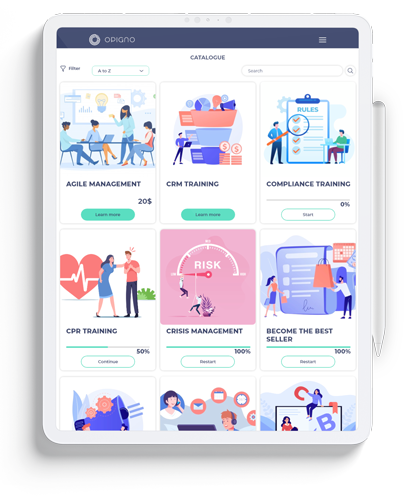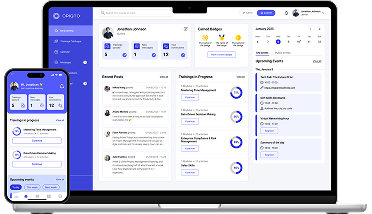A learning management system (LMS) is a powerful tool to help you create, deliver, and manage training in your organization. You can use a LMS to manage every aspect of your training, whether digital training content or live sessions.
From getting new hires up to speed to training employees on products and compliance, every organization has a range of training needs that get more complex as the company grows. A LMS takes away some of the headache of managing that training.
Here are five ways using a LMS to manage training will benefit your organization.
Update content with the touch of a button
With a learning management system, all content is in a central location, rather than stored on an employee’s computer or in a physical packet. That makes it simple to keep content current. When it’s time to update company policies in the new hire orientation or replace a video in a soft skills training, you only need to log into the LMS and make the change.
This is especially important for companies in highly regulated industries, where compliance training is critical. Keep on top of updated compliance standards and new laws by changing them in the LMS.
Track learner progress and performance

Stop wondering if users are getting anything out of your training, and log into the dashboard of your LMS to find out for sure. You can quickly see if users have completed modules, get a history of attempts and scores per user for every module, and note areas where learners are having trouble.
With this information at your fingertips, you can reach out to learners who are struggling in order to offer more resources. You can also get the big picture view of how well your training modules are performing, and make changes if it seems like multiple users are stuck in the same place.
Learn more about setting up user profiles with Opigno.
Engage users more thoroughly
With a LMS, users also get a dashboard where they can log in and track their own progress. This allows them to be more self-directed when it comes to required training, and proactive about seeking out and enrolling in other training your organization offers.
Plus, a LMS lets you use blended learning, multimedia, interactive microlearning, and social learning — which are all great ways to boost user engagement and retention. The Research Institute of America found that learners have a retention rate of 25% to 60% with e-learning, as opposed to 8-10% in traditional in-person training.
Anyone who stops learning is old, whether at twenty or eighty. Anyone who keeps learning stays young.
Henry Ford
Make training more accessible

If your LMS is cloud-based and mobile-friendly, users can access training modules from anywhere. That makes training more accessible to your global workforce and remote workers, as well as other employees who may want to brush up on training on their commute or lunch break.
The ability to deliver training in multiple ways also makes the content more accessible to employees with different learning styles or disabilities.
Easily adapt training to every user
A LMS can also allow you to build adaptive learning pathways into your training, which is a great way to provide personalized learning at a larger scale.
For example, a product training for the customer service team could start with a test on their product feature knowledge. Learners could then be given additional modules based on where it seems they need help.
Learn more about how Opigno’s open source LMS platform can help you save time, engage users, and improve your training program.
Published on January 29, 2021
